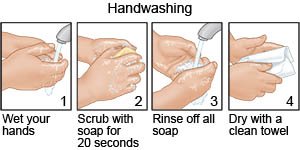Blister
Medically reviewed by Drugs.com. Last updated on Apr 6, 2025.
What is a blister?
A blister is a fluid-filled pocket on the surface of your skin. The fluid may be serum, blood, or other fluid, depending on what caused the blister. A layer of fluid is created to protect the skin until it heals. Blisters usually heal on their own within 2 weeks.
How should I care for my blister?
Do not pop your blister or tear the skin on it. This could cause infection and slow the healing process. The following will help protect your blister area:
- Wash your hands before you care for your blister. This will help prevent infection. Use soap and water, or a gel-based hand sanitizer if soap and water are not available.

- Cover your blister with a bandage, if needed. A bandage can help prevent the blister from being torn or popped. If the blister does break open, a bandage can will keep the area clean prevent infection.
- Use a bandage that is large enough to cover the entire blister. This will prevent the bandage from sticking to the blister. Your healthcare provider may tell you to use certain moist bandages or hydrogels.
- You may need a bandage that absorbs well if your blister has a lot of fluid. You may be told to wear a second bandage for extra protection.
- Carefully remove your bandage to care for the area. If the bandage sticks to your blister, pour saline on it. This will help the bandage come off more easily and prevent more skin damage.
- Apply clean bandages as directed. Change your bandages when they get wet, dirty, or soaked with fluid.
- Keep the blister area clean and dry. Wash the area with soap or saline and water. Gently pat the area dry. Look for signs of infection, such as redness, swelling, or pus.
What can I do to prevent a blister?
- Apply a thick skin cream or ointment. This can help prevent friction. Your healthcare provider may recommend a certain product.
- Choose clothes that do not bind, rub, or irritate your skin. Some fabrics can prevent blisters by wicking moisture away from your skin. Choose fabric that allows air to flow around your skin. Light clothing that fits loosely prevents friction as you move. Wear work gloves when you use tools such as a rake or a hammer.
- Protect your feet. Keep your feet clean and dry during the day. Wear shoes that fit well. Shoes that rub your feet may cause or worsen blisters. Cushioned insoles, padding, or moleskin can keep your feet from rubbing in your shoes. You can also wear 2 pairs of socks to give your feet more protection.
- Use padding to protect pressure areas, such as your heels. Gauze, moleskin, or similar padding can prevent or relieve pressure. You can also use padding to protect an area that has a blister. Make a hole in the middle of the padding. Place the padding so the blister goes through the hole. Cover the entire area with a bandage.
- Stop your activity if a red area forms. Red or painful skin during activity may be a sign that a blister could form. You may need to stop and add padding or a bandage to the area. You may need to change clothing or your shoes.
Drugs used to treat this and similar conditions
Dupixent
Dupixent is used to treat eczema, eosinophilic or oral-corticosteroid-dependent asthma, chronic ...
Omvoh
Omvoh is used to treat moderate to severe ulcerative colitis or Crohn's disease in adults. This ...
Prednisone
Prednisone is used to treat allergic disorders, ulcerative colitis, psoriasis and arthritis. Learn ...
Desonide topical
Desonide topical is used for allergies, atopic dermatitis, dermatitis, eczema, psoriasis
Elocon
Elocon is a topical steroid used to treat inflammation and itching caused by allergic reactions and ...
Xylocaine Jelly
Xylocaine Jelly is used for anal itching, anesthesia, burns, external, gastrointestinal surgery ...
Dupilumab
Dupilumab (Dupixent) is used to treat eczema, eosinophilic or oral-corticosteroid-dependent asthma ...
Hydrocortisone topical
Hydrocortisone cream is used to treat eczema, dermatitis, psoriasis, hemorrhoids, insect bites or ...
Mometasone topical
Mometasone topical is used for allergies, atopic dermatitis, dermatitis, eczema, psoriasis
Treatment options
The following list of medications are related to or used in the treatment of this condition.
When should I seek immediate care?
- You see signs of infection, such as red streaks, pus, or swelling.
When should I call my doctor?
- You have increased pain, redness, and swelling in the blister area.
- You notice a bad-smelling fluid coming from your blister.
- The blister does not heal within 2 weeks, or when your healthcare provider recommended.
- You have a fever, chills, or body aches.
- You have questions or concerns about your condition or care.
Care Agreement
You have the right to help plan your care. Learn about your health condition and how it may be treated. Discuss treatment options with your healthcare providers to decide what care you want to receive. You always have the right to refuse treatment. The above information is an educational aid only. It is not intended as medical advice for individual conditions or treatments. Talk to your doctor, nurse or pharmacist before following any medical regimen to see if it is safe and effective for you.© Copyright Merative 2025 Information is for End User's use only and may not be sold, redistributed or otherwise used for commercial purposes.
Learn more about Blister
Treatment options
Care guides
Symptoms and treatments
Medicine.com guides (external)
Further information
Always consult your healthcare provider to ensure the information displayed on this page applies to your personal circumstances.
